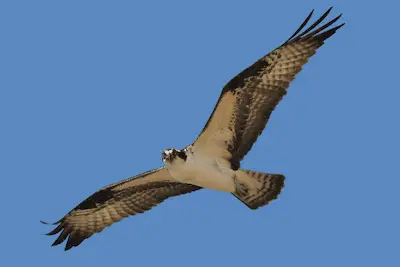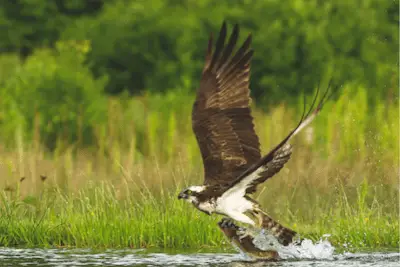European Osprey
(Pandion haliaetus)
The Osprey is one of the most widespread raptor species in the world, and also occurs throughout large parts of Europe.

However, in central, western, and southern Europe, the breeding populations of Ospreys are very low, and have been driven to extinction, or near extinction in many European countries.
Ospreys are thus a rare sight in most parts of Europe, and the most common way to see them is during migration, when thousands of Scandinavian Ospreys migrate through central and southern Europe on their way to Africa.
Fortunately enough, strict conservation efforts and provision of nesting sites are showing promising results in some European countries, where Osprey populations are starting to recover.
European Osprey facts
As fish eating specialists, Ospreys are most commonly observed close to water, except during migration, when they can be encountered far away from water.
Osprey Size
The Osprey is a big raptor and has a larger wingspan than a Common Buzzard (Buteo buteo), but smaller than a Golden Eagle (Aquila chrysaetos).
- Wingspan: 150-170 cm
- Length: 55-50 cm
- Weight: 1,600-2,100 g (female), 1,300-1,600 g (male)
The German name of the Osprey is “Fischadler”, which translates to “Fish Eagle”, and this already suggests that in terms of size, the Osprey is more similar to European eagles than it is to smaller raptors in Europe.
But keep in mind that male Ospreys are significantly smaller than females, and are just slightly larger than European species of buzzards.
Appearance
The Osprey looks like a large raptor with long, relatively slender wings, and a short tail. In good light conditions, its characteristic black and white coloration are also a great way to identify an Osprey, and these colors are unique among the different raptor species in Europe.

Sexual dimorphism
Similar to almost all European raptor species, female Ospreys are significantly larger than males, and the two genders basically don’t overlap in size. Otherwise, there are no differences between the two genders.
Lifespan
A maximum age of 32 years has been documented in the wild, making the Osprey one of the raptor species with the longest lifespan.
Scientific name and taxonomy
The scientific name of the Osprey is Pandion haliaetus. There are four species known globally, only one of which occurs in Europe. The Osprey is evolutionarily far removed from all other raptor species, and some ornithologists actually don’t include it in the family Accipitridae, but instead place it in its own family, the Pandionidae.
European Osprey distribution
The Osprey has a global distribution, and in Europe is found in the UK, Scandinavia, central Europe, and extending eastwards from there to eastern Europe and Russia. However, while it has a broad distribution, several European countries only have few breeding pairs
Osprey habitat
The Osprey prefers habitat that is in direct proximity to bodies of water with plentiful fish supplies. This can be the seas coast, rivers, lakes, or artificial ponds and reservoirs. In order to breed successfully, the Osprey also needs suitable nesting trees, though it readily accepts artificial nesting sites in many locations.
European Osprey population size
The European population of the Osprey is estimated to be between 8,000 and 11,000 breeding pairs, most of which are found in Scandinavia, Finland, and northern Russia. Sweden has the largest number of Ospreys (with up to 4,100 pairs), followed by Russia (up to 4,000 pairs), and Finland (up to 1,300 pairs).
Osprey behavior
The most commonly observed Osprey behavior is hunting for fish in lakes, rivers, and coastal waters. Ospreys fly slowly at medium height over the water surface, and stoop down into the water when they spot suitable prey.
Unlike other raptor species that like to catch fish at the water surface, Ospreys dive deeper into the water, and regularly become completely submerged while trying to grab a fish. This is in contrast to White-tailed Eagles (Haliaeetus albicilla), which only insert their talons into the water when catching fish.
Feeding and diet
European Ospreys feed almost exclusively on fish, and are highly specialized for catching fish. The main fish species taken depends on the location, and Ospreys are very flexible in their choice of fish species.
In general, the size of fish taken by Ospreys is between 50 and 500 g, but sometimes larger fish are also caught, though a large fish can be problematic for an Osprey to lift out of the water.
Breeding
The Osprey builds a large stick nest on top of pine trees. If no suitable trees are available, it also uses power poles, or artificial nesting platforms provided by local nature conservationists. On some islands, the Osprey also builds its nest in cliffs.
The female lays 2-4 eggs, which are incubated for up to 42 days. After hatching, young Ospreys stay in the nest for up to 60 days, and continue to be fed by their parents until the start of the autumn migration.
Osprey Migration
Ospreys are long-distance migratory birds that cross the equator to winter in Africa south of the Sahara. In some areas of southern Europe, including Spain, a few Ospreys are observed during winter every year, and this number appears to be on the rise.
Similar to other large raptors, Ospreys follow “migration corridors”, which take them south along specific routes that fall between mountain ridges, and they usually cross the Mediterranean sea at its narrowest straits, including Spain/Gibraltar, Italy/Sicily, and Greece/Cyprus.
European Osprey conservation status
While Osprey populations declined precipitously in large parts of Europe during the 20th century, due to direct persecution, there is an encouraging trend in many countries.
Due to strict protection and conservation measures Osprey populations are growing in Germany, Scotland, Scandinavia, and France. European Ospreys are even recolonizing areas where they had been driven to extinction.
BirdLife International classifies the conservation status of the Osprey as of “Least Concern”, due to its large distribution range and stable population numbers in recent years.
Threats
The biggest threat to Ospreys is illegal shooting, which was common in many parts of Europe until quite recently. After direct persecution, the biggest problem for Ospreys is the lack of suitable nesting trees, but fortunately this can be addressed by providing artificial nesting sites, which are readily accepted by Ospreys.
Additional resources:
- Steppe Eagle habitat and distribution
- Short-toed Eagle feeding and diet
- Lesser Spotted Eagle breeding and reproduction
